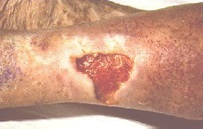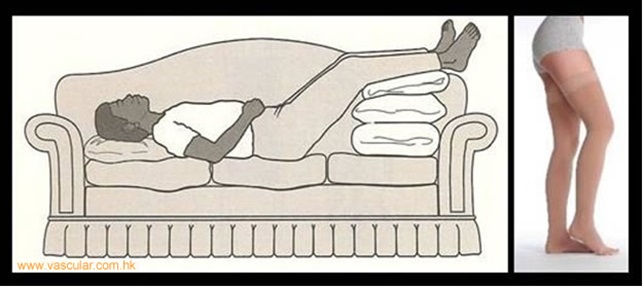Varicose veins is a manifestation of chronic venous disease (CVD) and are characterized by tortuous, often palpable subcutaneous veins with reversed blood flow3. The condition can occur anywhere in the body where there is poor venous return; however, they are most often associated with the lower limb.2 (Figure 1)

Figure 1
The incidence increases with age and whilst there is only a slightly higher prevalence in women than men, women are five times more likely to get it.
Varicose veins are weakly associated with1:
- Family history
- Pregnancy
- Obesity
- Posture (standing or sitting for long periods)
- Oral contraceptive pill
- Hormone replacement therapy
Sign & symptoms
Commonly reported symptoms include1:
- Aching (heaviness often relieved by elevation)
- Itching
- Ankle swelling
- Restlessness
- Cramps
A significant number of patients with varicose veins seek a medical opinion because they are worried about their cosmetic appearance2. It is estimated that 3–6% of people who have varicose veins in their lifetime will develop venous ulcers3.
Complication
Complications of varicose veins occur in up to 7% and may be associated with significant morbidity1:
- Bleeding – traumatic or spontaneous bleeding from a large varicosity.
- Inflammation – superficial thrombophlebitis; inflammation of the venous wall with localized thrombosis causing redness of the skin and tenderness of the affected area.

Figure 2
- Cosmetic effect:
- venous eczema-pigmentation of the skin due to deposits of degradation of extravagated red cells
- lipodermatosclerosis – chronic inflammation of subcutaneous fat with diffuse fibrosis and fat necrosis which leads to induration and swelling of the skin around the ankle.
- Chronic ulceration caused by chronic venous hypertension produces non healing scar on the skin.(Figure 2)
Treatment
There are several options for the management of varicose veins, including3:
A. Advice and reassurance
Advice on:
- Weight loss
- Light to moderate physical activity
- avoiding factors that are known to make their symptoms worse
- When and where to seek further medical help.
- What treatment options are available?
- The expected benefits and risks of each treatment option.
- That new varicose veins may develop after treatment.
- That they may need more than 1 session of treatment.
- That the chance of recurrence after treatment for recurrent varicose veins is higher than for primary varicose veins.
B. Interventional treatment in a vascular surgery clinic
Treatment is offered to patients with significant complications of varicose veins (as described above) or if the symptoms are significantly affecting their quality of life2.
After confirmation of diagnosis of varicose veins with a duplex ultrasound, treatment that can be offer to patients:
- Endothermal ablation and Endovenous laser treatment of the long saphenous vein.
- If endothermal ablation is unsuitable,offer for an ultrasound-guided foam sclerotherapy.
- If ultrasound-guided foam sclerotherapy is unsuitable, offer surgery.
C. Non interventional treatment
Compression hosiery has been shown to improve the symptoms of patients with uncomplicated varicose veins. Unfortunately, compliance is often poor as they should be worn continually when not in bed. There is no evidence that compression reduces recurrence or prevents progression of varicose veins 1.
Patients often find wearing compression hosiery is uncomfortable, difficult to apply and remove and cosmetically unsightly; non-adherence rates are as high as 33%.2
The advantage of compression hosiery is that it has few side effects2. Poor fitted stockings can cause skin necrosis and the risk increases in patients who are diabetic or who have impaired blood supply or sensation1.
Prevention
Prevention of symptomatic varicose veins mainly involves in changing ones’ lifestyle.Conservative management that includes lifestyle changes related to weight loss and the elevation of the legs may also be included along with compression therapy4.
Education on:
- Daily skin care-use of a mild soap and lukewarm water followed by the application of a petrolatum-based moisturizer.
- The types of clothing to avoid wearing constrictive clothing, such as knee-high or panty hose stockings, that can restrict the flow of blood in the lower extremities.
- The need to elevate the legs above the level of the heart for about 30 minutes 4 times each day, and the need to avoid having the legs in the dependent position for prolonged periods of time to avoid the pooling of blood in the legs.(Figure 3)
- The need for lower extremity exercises to aid the calf muscles in the return of blood to the heart. Leg exercises that can be done include walking (slightly uphill if possible), tiptoe movements that involve standing and rising up on the tips of the toes while holding onto a bar or other form of support, and dorsiflexion and plantar flexion of the feet several times each day.

Figure 3
References
- Rebecca et al, varicose veins. Surgery 259-262. 2010
- Sarah et al, varicose veins and its management. Surgery 211-217.2013
- NICE clinical guideline: The diagnosis and management of varicose veins. July 2013
- Sylvia et al. Varicose Veins: Diagnosis, Management, and Treatment. JNP 417-424. 2014
| Last reviewed | : | 28 August 2020 |
| Writer | : | Dr. Mohd Sufian b. Adenan |
| Accreditor | : | Dato’ Dr. Hj. Md Hanip b. Rafia |
| Reviewer | : | Dr. Nor Faizah bt. Ghazali |







